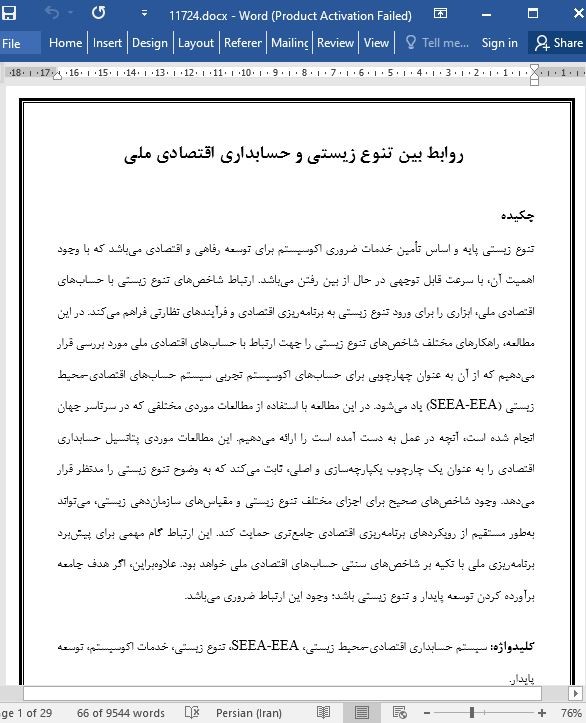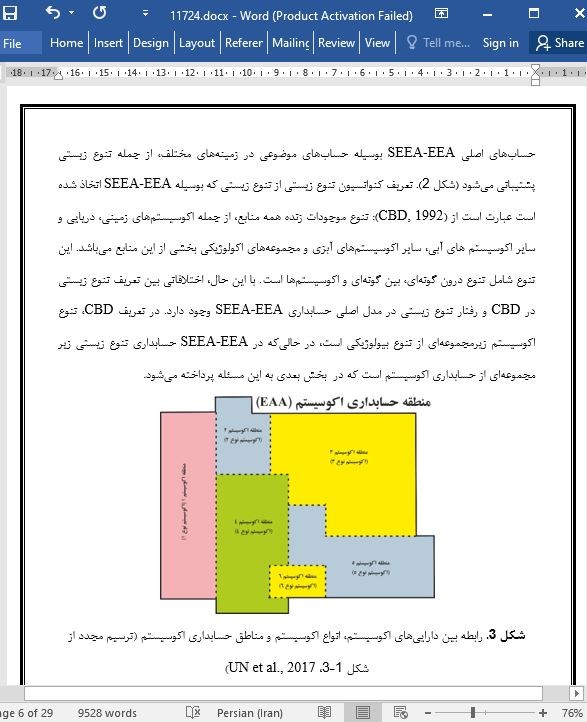
روابط بین تنوع زیستی و حسابداری اقتصادی ملی
چکیده
تنوع زیستی پایه و اساس تأمین خدمات ضروری اکوسیستم برای توسعه رفاهی و اقتصادی میباشد که با وجود اهمیت آن، با سرعت قابل توجهی در حال از بین رفتن میباشد. ارتباط شاخصهای تنوع زیستی با حسابهای اقتصادی ملی، ابزاری را برای ورود تنوع زیستی به برنامهریزی اقتصادی و فرآیندهای نظارتی فراهم میکند. در این مطالعه، راهکارهای مختلف شاخصهای تنوع زیستی را جهت ارتباط با حسابهای اقتصادی ملی مورد بررسی قرار میدهیم که از آن به عنوان چهارچوبی برای حسابهای اکوسیستم تجربی سیستم حسابهای اقتصادی-محیط زیستی (SEEA-EEA) یاد میشود. در این مطالعه با استفاده از مطالعات موردی مختلفی که در سرتاسر جهان انجام شده است، آنچه در عمل به دست آمده است را ارائه میدهیم. این مطالعات موردی پتانسیل حسابداری اقتصادی را به عنوان یک چارچوب یکپارچهسازی و اصلی، ثابت میکند که به وضوح تنوع زیستی را مدنظر قرار میدهد. وجود شاخصهای صحیح برای اجزای مختلف تنوع زیستی و مقیاسهای سازماندهی زیستی، میتواند بهطور مستقیم از رویکردهای برنامهریزی اقتصادی جامعتری حمایت کند. این ارتباط گام مهمی برای پیشبرد برنامهریزی ملی با تکیه بر شاخصهای سنتی حسابهای اقتصادی ملی خواهد بود. علاوهبراین، اگر هدف جامعه برآورده کردن توسعه پایدار و تنوع زیستی باشد؛ وجود این ارتباط ضروری میباشد.
1. مقدمه
اهمیت تنوع زیستی در رفاه انسانی امری ثابت شده میباشد (مانند: IPBES, 2019; MA, 2005; TEEB, 2010) که در چندین تعهدنامه بینالمللی (مانند: اهداف توسعه پایدار سازمان ملل متحد و کنوانسیون تنوع زیستی با اهداف Aichi) مورد تأکید و صیانت قرار گرفته است. بسیاری از نهادهای بیولوژیکی، از جمله انواع نهادهای مستقل که از تنوع زیستی تشکیل شدهاند به طور مستقیم در رفاه انسانی نقش دارند (مانند: ماهیگیری، محصولات جنگلی غیرچوبی، تماشای حیات وحش و گرده افشانی). به طور کلی، تمام تنوع زیستی، کلیدی برای حفظ کارکرد اکوسیستم میباشد (Devictor et al., 2010; Díaz et al., 2007; Hooper et al., 2005) که هر کدام از آنها، مجموعه گستردهای از خدمات اکوسیستم را که به نفع مردم میباشد، بطور غیرمستقیم تأمین میکند (Balvanera et al., 2014, 2006; Cardinale et al., 2012; Tilman et al., 2006). همچنین، تنوع زیستی نقش حیاتی در حفظ منابع و جریان خدمات اکوسیستم دارد؛ به ویژه در زمان آشفتگیها یا تنشهایی مانند: نوسانات آب و هوایی، حوادث آلودگی یا آتشسوزیها که ممکن است اکوسیستمها تجربه کنند. این تابآوری از طریق همارزی کارکردی به دست میآید؛ بدین معنی که ابعاد مختلف تنوع زیستی (مانند: گونهها) میتواند عملکردهای مشابه اکوسیستم داشته باشد اما به روشهای مختلف تحت تأثیر آشفتگی قرار میگیرد (Elmqvist et al., 2003; Mori et al., 2013).
6. نتیجهگیری
این مقاله نقاط ورودی متعددی برای دادههای تنوع زیستی در هسته حسابهای فیزیکی SEEA-EEA برجسته میکند که اهمیت حسابهای گونهای برای یکپارچهسازی این جز از تنوع زیستی در SEEA-EEA را مشخص میسازد. این مقوله، مدیریت ارائه خدمات اکوسیستم را به خوبی نمایان میسازد که به طور مستقیم مربوط به گونهها و خدمات بیشماری است که از طریق تعاملات گونهها با محیط غیرزنده ایجاد میشوند.
Abstract
Biodiversity underpins the supply of ecosystem services essential for well-being and economic development, yet biodiversity loss continues at a substantial rate. Linking biodiversity indicators with national economic accounts provides a means of mainstreaming biodiversity into economic planning and monitoring processes. Here we examine the various strategies for biodiversity indicators to be linked into national economic accounts, specifically the System of Environmental-Economic Accounts Experimental Ecosystem Accounting (SEEA EEA) framework. We present what has been achieved in practice, using various case studies from across the world. These case studies demonstrate the potential of economic accounting as an integrating, mainstreaming framework that explicitly considers biodiversity. With the right indicators for the different components of biodiversity and scales of biological organisation, this can directly support more holistic economic planning approaches. This will be a significant step forward from relying on the traditional indicators of national economic accounts to guide national planning. It is also essential if society’s objectives for biodiversity and sustainable development are to be met.
1. Introduction
The importance of biodiversity to human well-being is well established (e.g., via IPBES, 2019; MA, 2005; TEEB, 2010) and enshrined in multiple international commitments (e.g., the United Nations (UN) Sustainable Development Goals (SDGs) and the Convention on Biological Diversity’s (CBD) Aichi Targets). Many of the biological entities constituting biodiversity, including individual species, contribute directly to human well-being (e.g., fisheries, non-timber forest products, wildlife watching and pollination). More generally, biodiversity as a whole is key to maintaining ‘ecosystem functioning’ (Devictor et al., 2010; Díaz et al., 2007; Hooper et al., 2005) and, in turn, indirectly supplying a broad set of ecosystem services that benefit people (Balvanera et al., 2014, 2006; Cardinale et al., 2012; Tilman et al., 2006). Biodiversity is also critical in maintaining ecosystem services flows during times of disturbance or stress that ecosystems may experience, for example, climate variability, pollution incidents or fires. This resilience is achieved via ‘functional redundancy,’ where different aspects of biodiversity (e.g., species) can perform similar ecosystem functions, but are affected by disturbance in different ways (Elmqvist et al., 2003; Mori et al., 2013).
6. Conclusions
This paper highlights multiple entry points for biodiversity data in the core biophysical accounts of the SEEA EEA. It argues the importance of Species Accounts for integrating this component of biodiversity in to the SEEA-EEA. This will better inform management of the supply of ecosystem services directly related to species and the myriad of services that arise via the interactions of species with the abiotic environment.
چکیده
1. مقدمه
2. تنوع زیستی و SEEA EEA
3. کاربرد تنوع زیستی از دیدگاه SEEA-EEA
3-1. رابطه تنوع زیستی با هسته حسابهای فیزیکی SEEA-EEA
3-2. حسابداری تنوع زیستی از دیدگاه مقیاس
4. مطالعات موردی در مورد حسابداری گونهها
4-1. حسابهای گونهای در مطالعه موردی در کشور اوگاندا
4-2. حسابهای استرالیایی برای گونههای در خطر انقراض و پروانهها
4-3. حسابهای تنوع زیستی سان مارتین در کشور پرو
5-1. رابطه تنوع زیستی با حسابهای اقتصادی بوسیله SEEA-EEA
6. نتیجهگیری
منابع
Abstract
1. Introduction
2. Biodiversity and the SEEA EEA
3. Applying a biodiversity perspective to the SEEA-EEA
3.1. Linking biodiversity to the core physical SEEA EEA accounts
3.2. Accounting for biodiversity at scale
4. Species Accounting case studies
4.1. Uganda Species Accounts
4.2. Australian accounts for endangered species and butterflies
4.3. Biodiversity accounts for San Martin, Peru
5. Discussion
6. Conclusions
References
- اصل مقاله انگلیسی با فرمت ورد (word) با قابلیت ویرایش
- ترجمه فارسی مقاله با فرمت ورد (word) با قابلیت ویرایش، بدون آرم سایت ای ترجمه
- ترجمه فارسی مقاله با فرمت pdf، بدون آرم سایت ای ترجمه



